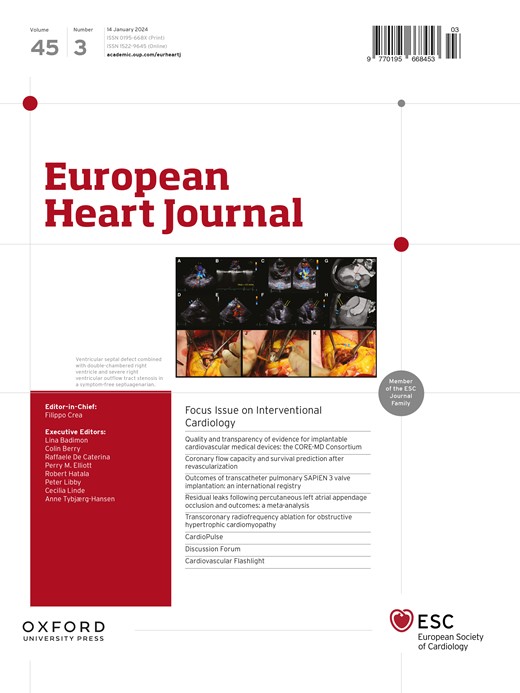与年龄有关的心脏淋巴管衰退会导致心脏水肿和巨噬细胞聚集
IF 35.6
1区 医学
Q1 CARDIAC & CARDIOVASCULAR SYSTEMS
引用次数: 0
摘要
随着预期寿命的大幅延长,与年龄相关的疾病,尤其是心血管疾病,已成为全球死亡的主要原因。衰老对心脏有多重影响,是心血管疾病的主要风险因素之一。在这方面,人们对微循环进行了广泛的研究。然而,负责排出过多组织液和免疫细胞的淋巴管对衰老相关病症的影响目前尚不清楚。为了研究衰老对淋巴管的影响,我们使用 LYVE1 和 PDPN 染色法检测了老年(>20 个月)和年轻(3 个月)小鼠心脏的淋巴毛细血管密度。衰老导致老年左心室心内膜下和心外膜区域的淋巴管密度显著降低(0.28±0.08 倍和 0.68±0.03 倍;p<0.05),而右心室没有变化。值得注意的是,在老年心脏中观察到(前)集淋巴管扩张,这表明淋巴管减少的同时,淋巴引流功能也出现了障碍。事实上,心脏衰老伴随着 CD68+ 巨噬细胞数量的增加、血浆蛋白纤维蛋白原和淀粉样蛋白在间质中的聚集。此外,我们还观察到衰老心脏的组织水肿明显增加(p<0.05)。与 3 个月大的小鼠相比,20 个月大的小鼠心脏淋巴管的减少与主要淋巴生长因子 Vegfc 的表达减少有关(0.72±0.04 倍;p<0.005)。为了确定淋巴功能障碍与年龄相关的心脏变化之间的因果关系,我们研究了 3 个月大的 Flt4;Prox1-CreERT2 小鼠的心脏,这些小鼠的淋巴管有缺陷。与野生型小鼠相比,这些小鼠尽管年龄较小,但也显示出纤维蛋白原(1.32±0.08 倍;p<0.05)和 CD68+ 巨噬细胞(1.58±0.08 倍;p<0.05)的积累。除此以外,还观察到其他与年龄相关的变化,如心脏肥大趋势;目前正在进一步研究中。同样,通过过表达 Flt4 的可溶性形式阻断年轻小鼠的 VEGFC 信号,会损害心脏淋巴毛细血管密度(0.62±0.06 倍;p<0.01),导致巨噬细胞和纤维蛋白原积累增加(1.69±0.09 倍,4.60±0.30 倍;p<0.001),这表明淋巴管的衰退会诱发一些与年龄相关的病症。最后,我们探讨了恢复老龄小鼠中Vegfc的表达能否挽救与年龄相关的心脏损伤。通过AAV9在老年小鼠体内过表达Vegfc可使心脏淋巴管密度恢复3倍,CD68+巨噬细胞密度降低1.6倍,但对纤维蛋白原的积累没有影响。总之,我们的研究表明,左心室淋巴密度、心脏水肿和炎症的降低与年龄有关。Vegfc的过表达可防止淋巴管随年龄增长而衰退,并减轻心脏炎症。本文章由计算机程序翻译,如有差异,请以英文原文为准。
Age-related decline in cardiac lymphatic vessels causes cardiac edema and macrophage accumulation
As life expectancy has significantly increased, age-related diseases, particularly cardiovascular diseases, have become a primary global cause of death. Aging has multiple effects on the heart and is one major risk factor for cardiovascular diseases. The microcirculation has been extensively studied in this context. However, the contribution of the lymphatic vasculature, which is responsible for draining excessive tissue fluid and immune cells, to age-related pathologies is currently unknown. To address the effect of aging on lymphatics, we examined lymphatic capillary density using LYVE1 and PDPN staining in old (>20 months) and young (3 months) mouse hearts. Aging induced a significant reduction in lymphatic vessel density in the sub-endocardial and –epicardial area of aged left ventricles, in both genders (0.28±0.08 fold and 0.68±0.03 fold; p<0.05), while the right ventricle showed no change. Notably, dilation of (pre-) collector lymphatics was observed in in old hearts, indicating, together with the lymphatic vessel reduction, a lymphatic drainage dysfunction. Indeed, cardiac aging was accompanied by increased numbers of CD68+ macrophages, accumulation of the plasma protein fibrinogen and amyloid into the interstitial space. Moreover, we observed a significant increase in tissue oedema in the aged hearts (p<0.05). The decline in lymphatic vessels was associated with a reduced expression of Vegfc (0.72±0.04 fold; p<0.005), a major lymphatic growth factor, in 20-month-old mouse hearts compared to their 3-month-old counterparts. To establish a causal link between lymphatic dysfunction and age-related cardiac changes, we examined hearts from 3-month-old Flt4;Prox1-CreERT2 mice, that have defective lymphatic vessels. Also these mice, despite their young age, displayed fibrinogen (1.32±0.08 fold; p<0.05) and CD68+ macrophage (1.58±0.08 fold; p<0.05) accumulation compared to wildtype littermates. Apart from these, other age-related changes, such as tendency to cardiac hypertrophy, were also observed; this is currently under further investigation. Likewise, blocking VEGFC signaling in young mice by overexpressing the soluble form of Flt4 impaired cardiac lymphatic capillary density (0.62±0.06 fold; p<0.01), leading to increased macrophage and fibrinogen accumulation (1.69±0.09 fold, 4.60±0.30 fold; p<0.001), suggesting that a decline of lymphatics induces some of the age-associated pathologies. Finally, we addressed whether restoring Vegfc expression in old mice can rescue age-related cardiac impairment. Overexpressing Vegfc via AAV9 in aged mice restored cardiac lymphatic density by 3-fold and reduced CD68+ macrophage density by 1.6-fold, without effect on fibrinogen accumulation. In conclusion, our study demonstrates an age-related reduction in left ventricular lymphatic density, cardiac edema and inflammation. Vegfc overexpression prevented the age-dependent decline of lymphatic vasculature and reduced cardiac inflammation.
求助全文
通过发布文献求助,成功后即可免费获取论文全文。
去求助
来源期刊

European Heart Journal
医学-心血管系统
CiteScore
39.30
自引率
6.90%
发文量
3942
审稿时长
1 months
期刊介绍:
The European Heart Journal is a renowned international journal that focuses on cardiovascular medicine. It is published weekly and is the official journal of the European Society of Cardiology. This peer-reviewed journal is committed to publishing high-quality clinical and scientific material pertaining to all aspects of cardiovascular medicine. It covers a diverse range of topics including research findings, technical evaluations, and reviews. Moreover, the journal serves as a platform for the exchange of information and discussions on various aspects of cardiovascular medicine, including educational matters.
In addition to original papers on cardiovascular medicine and surgery, the European Heart Journal also presents reviews, clinical perspectives, ESC Guidelines, and editorial articles that highlight recent advancements in cardiology. Additionally, the journal actively encourages readers to share their thoughts and opinions through correspondence.
 求助内容:
求助内容: 应助结果提醒方式:
应助结果提醒方式:


